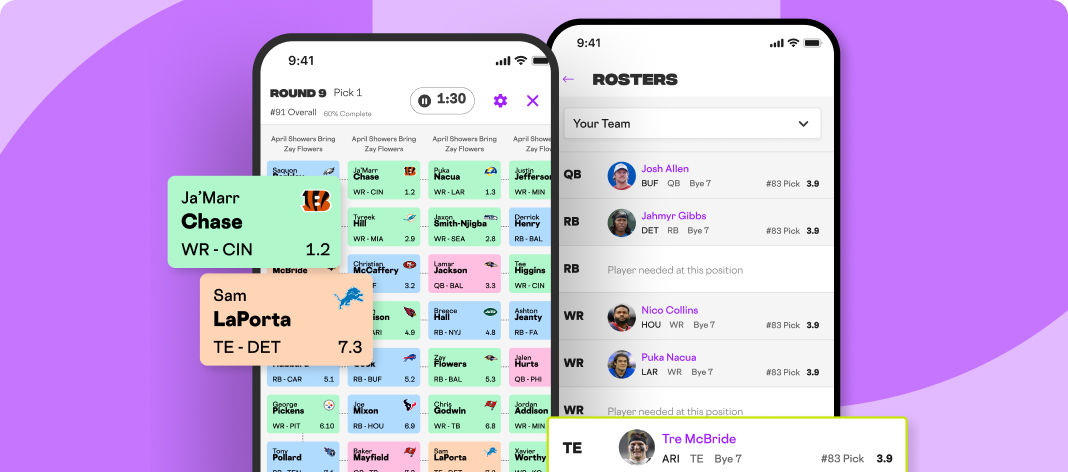Much of what I discuss below is a continuation of my work from Box Score Breakdown, the most thorough NFL weekly recap article around. The idea here is to pick out some of the most important developments from Week 3 and do a deep dive to see what they might mean for Week 4 and beyond.
1. RB Quinshon Judkins took 18 of Cleveland's 19 carries in Week 3.
- Key Stats: 80% RB opportunity share (W3) / -4.7% PROE for Browns (W2-3)
Jerome Ford still played in a lot of obvious passing situations (37% route share), but Judkins took nearly all of the work that had gone to Dylan Sampson the week before, with Sampson thus dropping to 7% snap share and a lone touch. Judkins finished with 58% snap share, 26% route share and an 18-94-1 rushing line, plus one catch for one yard on two targets (Ford got four targets).
What's more, Judkins actually looks good, averaging 5.5 YPC despite opening his career against the Ravens and Packers. A trip to Detroit in Week 4 doesn't look any easier, but it's slightly less intimidating after seeing how Kevin Stefanski ran the ball when trailing against Green Bay this past Sunday. Down 10-0 with 9:26 remaining, the Browns put together a 12-play FG drive on which Judkins took five carries for 58 yards (he also had two carries on the prior drive, also while down 10-0 in Q4).
Stefanski was quick to abandon the run in past
Much of what I discuss below is a continuation of my work from Box Score Breakdown, the most thorough NFL weekly recap article around. The idea here is to pick out some of the most important developments from Week 3 and do a deep dive to see what they might mean for Week 4 and beyond.
1. RB Quinshon Judkins took 18 of Cleveland's 19 carries in Week 3.
- Key Stats: 80% RB opportunity share (W3) / -4.7% PROE for Browns (W2-3)
Jerome Ford still played in a lot of obvious passing situations (37% route share), but Judkins took nearly all of the work that had gone to Dylan Sampson the week before, with Sampson thus dropping to 7% snap share and a lone touch. Judkins finished with 58% snap share, 26% route share and an 18-94-1 rushing line, plus one catch for one yard on two targets (Ford got four targets).
What's more, Judkins actually looks good, averaging 5.5 YPC despite opening his career against the Ravens and Packers. A trip to Detroit in Week 4 doesn't look any easier, but it's slightly less intimidating after seeing how Kevin Stefanski ran the ball when trailing against Green Bay this past Sunday. Down 10-0 with 9:26 remaining, the Browns put together a 12-play FG drive on which Judkins took five carries for 58 yards (he also had two carries on the prior drive, also while down 10-0 in Q4).
Stefanski was quick to abandon the run in past years, be it due to game script or ineffectiveness. Now coaching a team where some of the emphasis is shifting toward developing young talent, Stefanski could make it a point to continue giving Judkins touches even when the Browns are down bad.
For what it's worth, we saw the same thing with Ashton Jeanty this past weekend. He didn't get playing time in obvious passing situations like 3rd-and-long, but the Raiders continued running him on first/second down long after falling behind by 2-3 scores. With 28 called run plays in a blowout loss, the Raiders had a league-low -17.7% Pass Rate Over Expectation (PROE) in Week 3.
In two games with Judkins, the Browns rank 22nd in PROE (-4.7%). In Week 1, they were fifth (+4.6%). In 2023 and 2024, they were near the middle of the league overall but had stretches at both extremes (which is part of why I'm focusing on this). It's good news for Judkins' rushing production (and bad news for the Browns' pass catchers) if this doesn't end up being one of the Stefanski teams that throws 50 passes every time they fall behind or can't run well. That's still secondary to Judkins pushing Sampson and Ford aside, but it's something interesting to think about if you're one of the many people debating Judkins in a start/sit decision for Week 4.
2. RB TreVeyon Henderson played 84% of snaps on the final three drives in Week 3.
- Key Stats: Rhamondre Stevenson: 2.6% career fumble rate
Henderson didn't play much early in the game and produced just 47 yards on his 14 touches. This wasn't his breakout game, but it might have set the table, if only due to teammate failure. Rhamondre Stevenson fumbled twice, losing both, which makes him the most prolific fumbler in recent memory among RBs with considerable volume.
It was actually Antonio Gibson, not Henderson, who got most of the playing time right after Stevenson's second fumble. It wasn't a good sign for the rookie, except that Gibson then lost a fumble of his own in the third quarter (and barely played thereafter). Gibson also has a poor track record there, with 15 fumbles on 1,024 career touches (including special teams) equating to a 1.5% fumble rate.
For a point of comparison, Derrick Henry has never been known for ball security and still has a much lower career fumble rate (0.9%) than Gibson, to say nothing of Stevenson. I can't predict the future and tell you how New England's coaching staff will respond, but it does seem ridiculous to keep giving Stevenson chances at this point, especially when he wouldn't be a top player even without the fumbles.
Stevenson is in the first year of an extension, but with only $3.25 million guaranteed beyond 2025. The logical solution is to either release him or make him a healthy scratch. I'm not saying that's what the Patriots will do, but the possibility makes Henderson a lineup option in Week 4 against Carolina, and it also means Gibson should be rostered in all leagues. New England's backfield thus shapes up as one of the major fantasy storylines for Week 4.
3. RB Omarion Hampton played 87% of snaps after Najee Harris' season-ending injury.
- Key Stats: 118 total yards on 21 opportunities post-injury (100% of team RB share)
I didn't think Hampton looked great, or anything, but he mostly got what was blocked, avoided glaring mistakes and made a couple of big plays in the passing game. He won't necessarily play 80-plus percent of snaps going forward, but he might get that kind of opportunity share, with backup Hassan Haskins mostly handling clear passing situations and/or blowouts. Wheels up.
4. Puka Nacua and Jaxon Smith-Njigba are 1-2 among WRs in the following categories:
- Receiving Yards: Nacua (333), JSN (323)
- Targets Per Route Run: Nacua (43.2%), JSN (42.6%)
- Yards Per Route Run: JSN (4.8), Nacua (4.1)
You can start them even in your one-team league. My question is whether Nacua can break modern records for stuff like target rate and yards per route. I think his route share and the Rams offense aren't quite where we need them to be for a truly legendary fantasy season like Cooper Kupp's 2021, but it might not be too far off.
There's a bit more concern for regression with JSN, but also plenty of room to regress and still be getting huge volume by normal standards. He's also a top-five WR play, for now. It's just not the 100% lock that Nacua has now become as a top-of-the-board WR1 anytime both he and Matthew Stafford are reasonably healthy.
5. WR Tyquan Thornton is second in the NFL with 429 air yards
- Key Stats: 23.8 aDOT (1st) / 78% Route Share / 20.7% TPRR / 51% Air-Yard Share
It's easy to dismiss Thornton's early usage as purely a product of Kansas City's injury/suspension issues. That's certainly why he's getting such an opportunity in the first place, but the solid results so far could lead to a consistent role beyond Rashee Rice's suspension, especially with Hollywood Brown playing poorly and Xavier Worthy planning to fight through a dislocated shoulder.
In any case, neither Worthy nor Brown has ever seen this type of consistent attention from Mahomes on downfield passes, even though both have sub-4.4 speed. Thornton is a 4.29 guy in his own right, and he leads the league with 11 targets of 20-plus yards downfield, already more than halfway to Worthy's total (21) from his 20 appearances (including playoffs) last season. Thornton is one of just six WRs with more than half of his team's air yards this year, alongside Malik Nabers, Calvin Austin (yup), Tyreek Hill, Garrett Wilson and JSN.
There are some unsustainable aspects, namely the above-average target rate (20.7%) for a guy who leads the league in aDOT (23.8) and ranks third in average route depth (16.4)*. The target rate figures to drop, especially as Kansas City gets healthier, but there's room for efficiency growth to make up some of the difference.
Thornton has caught just three of his 11 deep targets, with the numerous near-misses including an overthrow by Patrick Mahomes on what should've been the easiest 75-yard TD of his career. There were also two plays where Thornton failed to make difficult contested catches, and then 2-3 others where he had a step of separation but Mahomes either threw it too far or too long. We saw a lot of those near-misses between Mahomes and Worthy last year, but that was on 1-2 deep targets a game, whereas Thornton is getting 3-4 per week while showing a similar nose for the end zone.
There's enough meat on the bone to make Thornton startable as a WR3 under standard scoring even if Worthy returns this Sunday to face Baltimore's talented, underperforming secondary. The Ravens are more vulnerable to underneath stuff, but that's true of most defenses these days, and the Chiefs have made a clear effort to unleash Thornton downfield in each of three games so far.
If he keeps it up, Thornton might even be the long-term No. 3 receiver in Kansas City (ahead of Hollywood Brown and JuJu Smith-Schuster) if/when the Chiefs return to full strength with both Worthy and Rice available. Thornton's 20.7% target rate isn't sustainable, but the steady route shares (and regular deep looks) could stick around into October and November.
*Some context here: Among 10 WRs with an average route depth of 15+ yards, only Thornton and Quentin Johnston (15.1) have a target rate above 18.2%. Among 12 WRs with an aDOT of 15+, only Thornton, Malik Nabers and Ricky Pearsall have a target rate above 18.5%.
6. Hunter Henry now leads TEs in air yards (214) and ranks third in PPR points
- Key Stats: 25.0% TPRR / 21.2% Target Share / 29.7% Air-Yard Share (No. 1 among TEs)
One lesson here is that Henry was/is undervalued. His draft price (and subsequent availability on waivers in some leagues) always made for a bargain, given his solid production and strong usage rates last season for one of the worst teams in the league. It was reasonable to think a better team would mean fewer targets, except that there's nothing improved about the Patriots besides QB Drake Maye.
It works out pretty well for Henry, who is solidly in that upper-middle class of NFL tight ends who are capable of taking on volume when needed but fit better as Option Cs in higher-functioning offenses. Jake Ferguson is another one of those guys, and also thriving right now, albeit with a very different receiving profile from Henry's, mostly catching check-downs rather than threatening the seams.
Whatever the case, Henry's solid usage from 2024 carried over to the first couple weeks of 2025, with 16.2% target share and 25% air-yard share through Week 2. It mostly went ignored, with just five catches on the 11 targets, but everyone is paying attention after Henry's Week 3 surge in terms of both volume and efficiency.
Henry won't actually continue as a high-end TE1, but when you look at his solid track record and his usage shares from both 2024 and 2025, the only logical conclusion is to at least promote him to the mid-TE1 pack. That's not much of an honor these days, but I'd argue that it puts Henry ahead of Dalton Kincaid, Mark Andrews, Travis Kelce and Zach Ertz, among others.
7. WR Drake London has 19.4% target share in two games since Darnell Mooney returned.
- Key Stats: 26.0% TS / 27.5% AYS / WR44 in PPR (10.0 ppg)
London has 12 targets and 110 air yards the past two weeks, although he's at least been reasonably efficient with eight catches for 104 yards. Mooney has 15 targets and 180 air yards, but with just six catches for 64 yards.
That disparity in effectiveness is one of the many reasons that volume inevitably will shift away from Mooney and toward London. Our concern here is the extent to which that's true, as London's second-round ADP was backed by talk of a potential 30 percent target share (after he got a whopping 39.8% in Penix's three starts last year).
London won't live up to his ADP if his target share is instead closer to 27% (the rate with Kirk Cousins last year), even if Penix turns things around to some extent and graduates to competence/mediocrity. What we've seen so far from London is minor disappointment in terms of volume and huge disappointment in terms of efficiency / team context. A WR1 fantasy season would be shocking, at this point. A Penix benching, not so much?*
*Penix is dead last in bad-throw rate (25.3), and his completion percentage is below 60% for a second straight year, even though his aDOT has plummeted from 10.1 (in 2024) to 7.2 (in 2025). As bad as it looks in a spreadsheet, the film might be worse. Penix is neither mobile, nor accurate. It's just hard to see a path with any upside; maybe he can become a low-end starter based on arm strength and intangibles.
8. RB Trey Benson took 75% of snaps after James Conner's season-ending injury
- Key Stats: 39 total yards on 7 opportunities (70% share) post-injury.
Benson lacks Conner's decisiveness and confidence, yet had already shown the Cardinals enough potential to earn a larger share of the backfield work early in his second season. That share now figures to explode, with only passing-down specialist Emari Demercado and journeyman Bam Knight (a healthy scratch so far) standing between Benson and large snap counts.
Demercado will probably play more than a lot of fantasy people want, but mostly on snaps where the ball doesn't go to the running back. Benson has 84 carries and 17 targets on 233 career snaps, getting the ball on 43.3 percent of his plays. Demercado, on the other hand, has a carry/target on just 29.1 percent of his 464 career snaps.
I'm still not sure if Benson has the skills and vision to match his athleticism, but he's at least shown competent hands so far, and the size-speed combination* hints at potential for breakaway runs (Conner's lone weakness). He's about to handle large workloads, and while Arizona's offense hasn't looked good so far, it at least has the seventh-highest cumulative RB target share (23.9 percent).
*Benson is listed at 6-1, 223. At the 2024 Combine, he ran a 4.39 40 at 6-0, 216.
9. WR Travis Hunter has 62% route share and 15% target share through three games.
- Key Stats: 62% and 68% snap shares on defense in Weeks 2 and 3
Hunter's snap share on offense has dropped slightly each week, down from 64% in Week 1 to 53% in Week 3. His targets have also dropped with each passing week, while route shares have lingered around 60 percent each game.
Hope for Year 1 fantasy value is rapidly drying up, especially after this past Sunday, when Dyami Brown left early with a shoulder injury and Hunter still wasn't full-time on offense. With Brown out after halftime, Hunter got 51% snap share overall, with 71% in 11 personnel.
We knew he wouldn't play much in heavier formations, but the hope was that Hunter would be a regular in three-wide sets. Instead, the Jaguars made Parker Washington an every-down player and gave No. 5 receiver Tim Patrick a bunch of the snaps/routes that might otherwise have gone to Hunter.
Meanwhile, Hunter seems to be settling in at cornerback, where he has more experience (and was expected to spend most of his time in the NFL, prior to the massive receiving season at Colorado in 2024). The Jaguars wanted him to focus on offense first, probably to make Liam Coen and Trevor Lawrence look good, but they seem to be shifting in the other direction now and viewing Hunter as a 50/50 guy.
10. RB Jaylen Warren got 78% snap share and 23 touches in Week 3.
- Key Stats: 61% route share / 83% RB opportunity share
This one may have snuck by some people, in part because Kenneth Gainwell vultured a TD after a sequence where Warren took carries on six consecutive plays. The Patriots also held Warren to 81 total yards, but it was the second straight week in which his usage increased while Kenneth Gainwell's declined.
In Week 1, the two RB had a fairly even split, with Gainwell getting slightly more playing time (52% vs. 45%) but Warren getting a couple more opportunities (13 vs. 11).
In Week 2, Warren rose to 58% snap share and had an 18-10 edge over Gainwell for opportunities, but the latter stll had a small advantage in route share (50% to 42%).
In Week 3, Warren got 78% of snaps and 61% of routes, taking 24 opportunities while Gainwell got just five.
It won't necessarily be the same Week 4 against Minnesota (in London), and we should see Kaleb Johnson get some kind of chance eventually, but things have definitely shifted in Warren's favor relative to where he started the season. His workload projection is good enough to make him a decent RB2 start even in a tough Week 4 matchup.





















